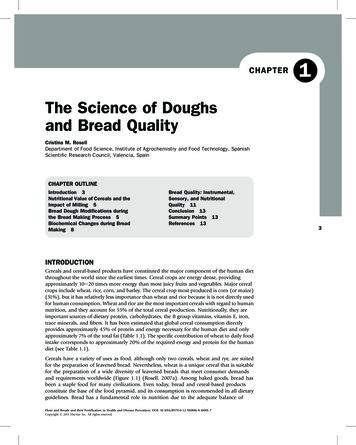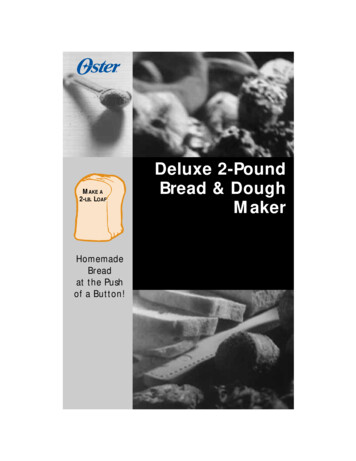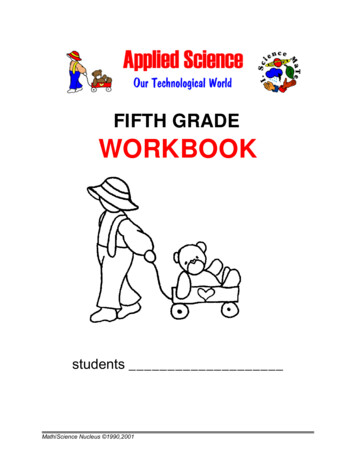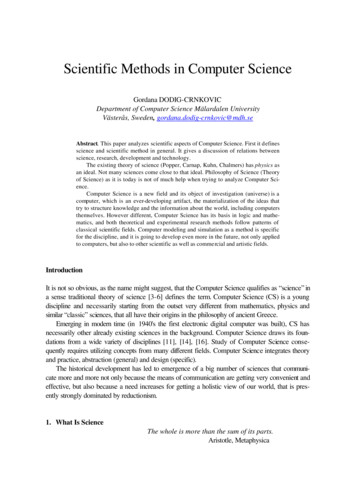
Transcription
CHAPTER1The Science of Doughsand Bread QualityCristina M. RosellDepartment of Food Science, Institute of Agrochemistry and Food Technology, SpanishScientific Research Council, Valencia, SpainCHAPTER OUTLINEIntroduction 3Nutritional Value of Cereals and theImpact of Milling 5Bread Dough Modifications duringthe Bread Making Process 5Biochemical Changes during BreadMaking 8Bread Quality: Instrumental,Sensory, and NutritionalQuality 11Conclusion 13Summary Points 13References 13INTRODUCTIONCereals and cereal-based products have constituted the major component of the human dietthroughout the world since the earliest times. Cereal crops are energy dense, providingapproximately 10e20 times more energy than most juicy fruits and vegetables. Major cerealcrops include wheat, rice, corn, and barley. The cereal crop most produced is corn (or maize)(31%), but it has relatively less importance than wheat and rice because it is not directly usedfor human consumption. Wheat and rice are the most important cereals with regard to humannutrition, and they account for 55% of the total cereal production. Nutritionally, they areimportant sources of dietary protein, carbohydrates, the B group vitamins, vitamin E, iron,trace minerals, and fibers. It has been estimated that global cereal consumption directlyprovides approximately 45% of protein and energy necessary for the human diet and onlyapproximately 7% of the total fat (Table 1.1). The specific contribution of wheat to daily foodintake corresponds to approximately 20% of the required energy and protein for the humandiet (see Table 1.1).Cereals have a variety of uses as food, although only two cereals, wheat and rye, are suitedfor the preparation of leavened bread. Nevertheless, wheat is a unique cereal that is suitablefor the preparation of a wide diversity of leavened breads that meet consumer demandsand requirements worldwide (Figure 1.1) (Rosell, 2007a). Among baked goods, bread hasbeen a staple food for many civilizations. Even today, bread and cereal-based productsconstitute the base of the food pyramid, and its consumption is recommended in all dietaryguidelines. Bread has a fundamental role in nutrition due to the adequate balance ofFlour and Breads and their Fortification in Health and Disease Prevention. DOI: 10.1016/B978-0-12-380886-8.10001-7Copyright Ó 2011 Elsevier Inc. All rights reserved.3
SECTION 1Flour and BreadsTABLE 1.1 Contribution of Cereals to the Daily Food IntakeTotalCerealsWheatMilled riceBarleyMaizeRyeOatsMilletSorghumOther cerealsFood Consumption(kg/Capita/Year)Food Consumption(kcal/Capita/Day)Protein Consumption(g/Capita/Day)Fat 20.030.050.350.330.02Source: Food and Agriculture Organization (2007).AB4CDFFIGURE 1.1Different types of breads. There is a widediversity of leavened breads that meetconsumer demands and requirementsworldwide. (A and B) Crusty bread namedciabatta, (C) baguette, (D and E) panbread, (F) partially baked bread, and(G) fiber-enriched bread.EG
CHAPTER 1The Science of Doughs and Bread Qualitymacronutrients in its composition; in addition, it provides some micronutrients andminerals.NUTRITIONAL VALUE OF CEREALS AND THE IMPACT OF MILLINGAll cereal grains have a fairly similar structure and nutritive value, although the shape and sizeof the seed may be different. In this chapter, wheat is used as a reference because it is the base ofmore foods than any other grain and the basis for the preparation of leavened bread; hereafter,the discussion refers to wheat grain.The chemical components of cereals are not evenly distributed in the grain. Table 1.2 providesthe nutritive value of the three main different parts in wheat. Bran, which represents 7% of thegrain, contains the majority of the grain fiber, essentially cellulose and pentosans. It is a sourceof B vitamins and phytochemicals, and 40e70% of the minerals are concentrated in this outerlayer. The endosperm, the main part of the grain (80e85%), contains mostly starch. It haslower protein and lipid content than the germ and the bran, and it is poor in vitamins andminerals. The germ, the small inner core that represents approximately 21% of the grain, is richin B group vitamins, proteins, minerals such as potassium and phosphorous, healthfulunsaturated fats, antioxidants, and phytochemicals. Cereals are rich in glutamic acid, proline,leucine, and aspartic acid, and they are deficient in lysine. The amino acid content is mainlyconcentrated in the germ.Generally, cereal grains are subjected to different processes to prepare them for humanconsumption. These processes significantly affect their chemical composition andconsequently their nutritional value.The majority of wheat is milled into flour, which can be used to make many types of breadsthat differ in shape, structure, and sensory characteristics. Milling removes the fibrous layers ofthe grain; therefore, refined cereals do not have the same nutritional and health benefits as thegrain or wholemeal (see Table 1.2). Without the bran and germ, approximately 45% of thegrain proteins are lost, along with 80% of fiber, 50e85% of vitamins, 20e80% of minerals,and up to 99.8% of phytochemicals. In addition, important losses of amino acids (35e55%)occur during refining. Some fiber, vitamins, and minerals may be added back into refinedcereal products through fortification or enrichment programs, which compensates for lossesdue to refining, but it is impossible to restore the phytochemicals lost during processing(Rosell, 2007b).BREAD DOUGH MODIFICATIONS DURING THE BREADMAKING PROCESSA brief description of the bread making process is included so that the reader will understandthe physical and chemical constraints to which the cereal main biopolymers, constituents ofthe dough, are exposed during the process (for more detailed information, see Cauvain, 2003).Different alternatives have been developed for adapting bread making to consumer demandsand for facilitating the baker’s work (Figure 1.2). Bread making stages include mixing theingredients, dough resting, dividing and shaping, proofing, and baking, with great variation inthe intermediate stage depending on the type of product. During mixing, fermenting, andbaking, dough is subjected to different shear and large extensional deformations (includingfracture), which are largely affected by temperature and water hydration (Rosell and Collar,2009). Several physical changes occur during the bread making process, in which glutenproteins are mainly responsible for bread dough structure formation, whereas starch is mainlyimplicated in final textural properties and stability.In bread making, mixing is one of the key steps that determine the mechanical properties ofthe dough, which have a direct consequence on the quality of the end product. Mixing evenly5
SECTION 1Flour and BreadsTABLE 1.2 Proximate Composition (%) of Wheat and the Effect of the Milling Processon Nutrient Composition6Energy (kcal)Total carbohydrate (g)Dietary fiber (g)Total fat (g)Saturated fat (g)Monounsaturated fat (g)Polyunsaturated fat (g)Protein (g)Amino acidsTryptophan (mg)Threonine (mg)Isoleucine (mg)Leucine (mg)Lysine (mg)Methionine (mg)Cystine (mg)Phenylalanine (mg)Tyrosine (mg)Valine (mg)Arginine (mg)Histidine (mg)Alanine (mg)Aspartic acid (mg)Glutamic acid (mg)Glycine (mg)Proline (mg)Serine (mg)VitaminsVitamin A (IU)Vitamin E (mg)Vitamin K (mg)Thiamin (mg)Riboflavin (mg)Niacin (mg)Vitamin B6 (mg)Folate (mg)Pantothenic acid (mg)Choline (mg)MineralsCalcium (mg)Iron (mg)Magnesium (mg)Phosphorus (mg)Potassium (mg)Sodium (mg)Zinc (mg)Copper (mg)Manganese (mg)Selenium (mg)Source: Gramene (2009).Wheat 96.32398428921212.30.813.379.2
CHAPTER 1The Science of Doughs and Bread QualityConventionalbread makingRetardedproofing( 5ºC to —6ºC)Interruptedproofing(—7ºC to —18ºC)FrozendoughFrozenfermented doughBOT(bake MixingMixingMixingMixingMixingMixingDough restingDough restingDough restingDough restingDough restingDough lingInterruptedproofingFreezing andfrozen proofingThawingFreezing andfrozen BakingFull kingFIGURE 1.2Current methods of bread making. Different alternatives have been developed for adapting bread making to consumer demands and for facilitating thebaker’s work. Bread making stages include mixing the ingredients, dough resting, dividing and shaping, proofing, and baking, with great variation in theintermediate stage depending on the type of product.distributes the various ingredients, hydrates the component of the wheat flour, supplies thenecessary mechanical energy for developing the protein network, and incorporates air bubblesinto the dough. Each dough has to be mixed for an optimum time to fully develop, and atthis stage it offers maximum resistance to extension. The period of barely constant torquedetermines the dough stability, which is dependent on the flour and mixing method used.Undermixing may cause small unmixed patches that interfere in the proofing stage.Conversely, if the mixing is excessive, dough properties change from good (smooth and elastic)to poor (slack and sticky) (Sliwinski et al., 2004), and a decrease in the consistency is observed,which is attributed to the weakening of the protein network. Bread dough is a viscoelasticmaterial that exhibits an intermediate rheological behavior between a viscous liquid and anelastic solid. Bread dough must be extensible and elastic enough for expanding and holdingthe released gases, respectively.During initial mixing, wheat dough is exposed to large uni- and biaxial deformations.Moreover, the material distribution, the disruption of the initially spherical protein particles,and the flour component hydration occur simultaneously, and together with the stretchingand alignment of the proteins, this leads to the formation of a three-dimensional viscoelasticstructure with gas-retaining properties. The rheological properties of wheat flour doughs arelargely governed by the contribution of starch, proteins, and water. The protein phase of flourhas the ability to form gluten, a continuous macromolecular viscoelastic network, but only ifenough water is provided for hydration and sufficient mechanical energy input is suppliedduring mixing. The viscoelastic network plays a predominant role in dough machinability andaffects the textural characteristics of the finished bread (Collar and Armero, 1996). Theviscoelastic properties of the dough depend on both quality and quantity of the proteins, andthe size distribution of the proteins is also an important factor. Two proteins present in flour7
SECTION 1Flour and Breads(gliadin and glutenin) form gluten when mixed with water and give dough these specialfeatures. Gluten is essential for bread making and influences the mixing, kneading, and bakingproperties of dough. According to MacRitchie (1992), two factors contribute to doughstrength: the proportion of proteins above a critical size and the size distribution of theproteins. The properties of this network are governed by the quaternary structures resultingfrom disulfide-linked polymer proteins and hydrogen bonding aggregates (Aussenac et al.,2001). Dough mixing involves large deformations that are beyond the linearity limit, whichcorrelates with nonlinear rheological properties. The characterization of the viscoelasticbehavior exceeding the linear viscoelasticity requires specialized devices that record doughconsistency when subjected to mechanical stress and/or dual mechanical and temperatureconstraints (Rosell and Collar, 2009). The stability of failure in single dough bubble walls isdirectly related to the extensional strain hardening properties of the dough, which plays animportant role in the stabilization of bubble walls during baking.8During proofing or fermentation, yeast metabolism results in carbon dioxide release andgrowth of air bubbles previously incorporated during mixing, leading to expansion of thedough, which inflates to larger volumes and thinner cell walls before collapsing. The growth ofgas bubbles during proof and baking determines the characteristics of the bread structure andthus the ultimate volume and texture of the baked product. The yeast breaks carbohydrates(starch and sugars) down into carbon dioxide and alcohol during alcoholic fermentation.Enzymes present in yeast and flour also help to speed up this reaction. The carbon dioxideproduced in these reactions causes the dough to rise (ferment or proof), and the alcoholproduced mostly evaporates from the dough during the baking process. During fermentation,each yeast cell forms a center around which carbon dioxide bubbles are released. Thousands oftiny bubbles, each surrounded by a thin film of gluten, grow as fermentation proceeds.Kneading or remixing of the dough favors the release of large gas bubbles, resulting in a moreeven distribution of the bubbles within the dough.The size, distribution, growth, and failure of the gas bubbles released during proofing andbaking have a major impact on the final quality of the bread in terms of both appearance(texture) and final volume (Cauvain, 2003). As the intense oven heat penetrates the dough, thegases inside the dough expand, with a concomitant increase in the size of the dough. As thetemperature rises, the rate of fermentation and production of gas cells increases, and thisprocess continues until the temperature of yeast inactivation is reached (approximately 45 C).When proteins are denatured, the gluten strands surrounding the individual gas cells aretransformed into the semi-rigid structure that will yield the bread crumb. Endogenousenzymes present in the dough are inactivated at different temperatures during baking. Thesugars and breakdown products of proteins released from the enzyme activity are thenavailable to sweeten the bread crumb and participate in Maillard or nonenzymatic browningreactions, which are responsible for the brown color of the crust.In the past several decades, bread making processes have been adapted to consumer demands,and subzero and low temperatures have been included in flow diagrams for interrupting theprocesses before or after fermentation, or when partial baking is completed, for obtainingpartially baked breads (see Figure 1.1) (Rosell, 2009). These technologies have facilitated thelaunching of a great number of fresh-baked goods available at any time of the day, and overallthey help bakeries bring new products to the market quickly and successfully.BIOCHEMICAL CHANGES DURING BREAD MAKINGBread making is a dynamic process with continuous physicochemical, microbiological, andbiochemical changes caused by mechanicalethermal action and the activity of the yeast andlactic acid bacteria together with the activity of the endogenous enzymes. The changes in theflour biopolymeric compounds take place during mixing, proofing, and baking. Duringmixing, dough is exposed to large uni- and biaxial deformations and a continuous protein
CHAPTER 1The Science of Doughs and Bread Qualitynetwork is formed, which is stabilized by disulfide bonds and modified thiol/disulfideinterchange reactions. The input of mechanical energy that takes places during kneadingconfers the necessary energy for distributing flour components, favoring the protein interaction and the formation of covalent bonds between them, which finally leads to the formationof a continuous macromolecular viscoelastic structure. Depolymerization and repolymerization of the sodium dodecyl sulfate-unextractable polymers occurs by the repeated breakingand reforming of disulfide bonds within and between gluten proteins, where glutenin subunitsare released in a nonrandom order, indicating a hierarchical structure (Aussenac et al., 2001).Also in this structure, tyrosine cross-links contribute to dough elasticity, suggesting thata radical mechanism involving endogenous peroxidases might be responsible for dityrosineformation during bread making (Tilley et al., 2001).There is general agreement that gluten is the main contributor to the unique properties ofwheat dough properties, affecting dough characteristics and, consequently, the quality of thefresh bread. Gluten is a non-pure protein system, and although the nonprotein componentshave significant effects, the rheological properties of gluten derive from the properties andinteractions among proteins. Gluten proteins comprise two main subfractions: glutenins,which confer strength and elasticity, and gliadins, which impart viscosity to dough. Proteinsmainly involved in the viscoelastic properties of the dough are the high-molecular-weightglutenin subunits, which affect dough viscoelasticity in a similar and remarkable way as thewater content (Cauvain, 2003). Namely, the mixing process induces an increase in the amountof total unextractable polymeric protein and large unextractable monomeric proteins(Kuktaite et al., 2004). Specifically, the amount of high-molecular-weight glutenins increaseswith a parallel decrease in the amount of low-molecular-weight glutenins, gliadins, andalbumins/globulins (Lee et al., 2002). Mixing also promotes the solubilization of arabinoxylans due to mechanical forces, and this solubilization proceeds further during restingdue to endoxylanase activity, in addition to xylosidase and arabinofuranosidase activities(Dornez et al., 2007).The other large biopolymer that plays an important role in the bread making process is starch.Amylose and amylopectin are the constituents of the starch granule. This biopolymer providesfermentable sugars to yeast and has a significant contribution to dough rheology, especiallyduring the baking process (Cauvain, 2003). Pasting performance of wheat flours duringcooking and cooling involves many processes, such as swelling, deformation, fragmentation,disintegration, solubilization, and reaggregation, that take place in a very complex mediaprimarily governed by starch granule behavior. During heating, the native protein structure isdestabilized, and unfolding may facilitate sulfhydryledisulfide interchange reactions andoxidation together with hydrophobic interactions, leading to the association of proteins and,consequently, to the formation of large protein aggregates. Nevertheless, as the temperatureincreases, the role of the proteins becomes secondary, and changes involving the starchgranules become predominant. During this stage, starch granules absorb the water available inthe medium and they swell. Amylose chains leach out into the aqueous intergranular phase,promoting the increase in viscosity that continues until the temperature constraint leads to thephysical breakdown of the granules, which is associated with a reduction in viscosity. Duringcooling of the loaf, the gelation process of the starch takes place, in which the amylose chainsleached outside the starch granules during heating are prompted to recrystallize. The reassociation between the starch molecules, especially amylose, results in the formation of a gelstructure. This stage is related to the retrogradation and reordering of the starch molecules.In addition to these changes, it must be considered that bread making is a dynamic processwith continuous microbiological and chemical changes, motivated by the action of the yeastand lactic acid bacteria, which occur during proofing and the initial stage of baking. Yeasts andlactic acid bacteria contain different enzymes responsible for the metabolism of microorganisms that modify dough characteristics and fresh bread quality. Therefore, wheat flour,9
SECTION 1Flour and Breadsyeasts, and bacterial population of sour doughs are sources of different endogenous enzymesin bread making processes and exert an important effect on dough rheology and on thetechnological quality of bread (Rosell and Benedito, 2003). Different processing aids, namelyenzymes, are also used in bread making to improve the quality of the baked products byreinforcing the role of gluten, providing fermentable sugars, and/or contributing to stabilizethe hydrophobicehydrophilic interactions (Rosell and Collar, 2008).10Numerous biochemical changes occur during bread making that have direct effects on thesensory attributes and nutritional quality of the finished product. The contribution of lowmolecular-weight proteins to the taste and flavor of bread depends on the content of peptidesrich in basic and hydrophobic amino acids released during fermentation and baking, theproportion of hydrophilic peptides in unfermented bread, and the balance of endo- andexoprotease activities during those stages. Changes in the total or individual content of aminoacids and peptides during the different steps of bread making modify the organoleptic characteristics of the bread (Martinez-Anaya, 1996). Amino acids are absorbed by yeast and lacticacid bacteria and metabolized as a nitrogen source for growth, resulting in an increase in theamount of gas produced, raising the alcohol tolerance of yeast and improving the organolepticand nutritional quality of bread. They can also be hydrolyzed by the action of proteolyticenzymes from both flour and microorganisms on proteins as well as by yeast autolysis. Theamino acid profile during bread making reveals that the total amino acid content (particularlyfor ornithine and threonine) increases by 64% during mixing and then decreases 55% duringbaking, with the most reactive amino acids being glutamine, leucine, ornithine, arginine,lysine, and histidine (Prieto et al., 1990). Free amino acids in wheat flour and dough play animportant role in the generation of bread flavor precursors through the formation of Maillardcompounds during baking. In fact, leucine, proline, isoleucine, and serine reacting with sugarsform typical flavors and aromas described as toasty and breadlike, whereas excessive amountsof leucine in fermenting doughs lead to bread with unappetizing flavor (Martinez-Anaya,1996). The specific metabolic activities of fermentation microorganisms are responsible forthe dynamics in nitrogen compounds, showing different metabolic rates for acidic, basic,aliphatic, and aromatic amino acids. Lactic acid bacteria contain proteases and peptidases,which release into the media amino acids and peptides that are easily metabolized by yeast andlactic acid bacteria, showing different nutritional requirements and exoproteolytic andendoproteolytic activities depending on the strain of lactic acid bacteria (Collar and MartinezAnaya, 1994). In general, wheat doughs started with lactic acid bacteria show a gradualincrease in valine, leucine, and lysine during fermentation, and there is also an increase inproline but only during the initial hours of proofing. In addition, the action of proteinases andpeptidases from lactic acid bacteria on soluble polypeptides and proteins results in an increasein short-chain peptides that contribute to plasticize the dough and give elasticity to gluten.Jiang et al. (2008) observed a decrease in 17 amino acids in steamed bread; alanine underwentthe highest loss (17.1%), followed by tyrosine (12.5%), and leucine was the least affectedamino acid.Proteinelipid interactions in wheat flour dough also play an important role because bothlipids and proteins govern the bread making quality of flour. Lipids have a positive effect ondough formation and bread volume, namely polar lipids or the free fatty acid component ofthe nonstarch lipids, whereas nonpolar lipids have been found to have a detrimental effect onbread volume (MacRitchie, 1983). During mixing, more than half of the free lipids in flour areassociated with gluten proteins, although there is no consensus about the type of interactionsbetween lipids and proteins. However, evidence has been presented that nonpolar lipids areretained within the gluten network through hydrophobic forces, involving the physicalentrapment of lipids within the proteins (McCann et al., 2009). The same study suggests thatglycolipids are associated with glutenins through hydrophobic interactions and hydrogenbonds, whereas the phospholipids presumably interact with either the gliadins or thelipid-binding proteins.
CHAPTER 1The Science of Doughs and Bread QualityVitamin content is also affected during the bread making process. The yeasted bread makingprocess leads to a 48% loss of thiamine and 47% loss of pyridoxine in white bread, althoughhigher levels of these vitamins can be obtained with longer fermentations (Batifoulier et al.,2005). Native or endogenous folates show good stability in the baking process, and even anincrease in endogenous folate content in dough and bread compared with the bread flour wasobserved by Osseyi et al. (2001). Nevertheless, the bread making process with yeast fermentation is beneficial for reducing the levels of phytate content with the subsequent increase inmagnesium and phosphorus bioavailability (Haros et al., 2001).BREAD QUALITY: INSTRUMENTAL, SENSORY, AND NUTRITIONALQUALITYBread quality is a very subjective term that greatly depends on individual consumer perception,which in turn is affected by social, demographic, and environmental factors. The perception ofbread quality varies widely with individuals and from one bread to another. Scientific reportsfocused on the bread making process or recipes usually refer to instrumental methods forassessing quality, whereas studies focused on consumer preferences highlight the significantrelationship between sensory quality and consumer perception. Alternatively, healthy conceptsrelated to nutritional value are emerging as fundamental quality attributes of bread products(Table 1.3). Therefore, the global concept of bread quality could be integrated by instrumentalattributes, those that can be objectively measured; sensory sensations including descriptiveattributes related to consumer quality perceptions; and nutritional aspects related to healthiness and functionality of the bread products.Regarding instrumental quality (see Table 1.3), due to the existence of a great variety of breadsderived from different wheat grains, bread making processes, and recipes, it is almostimpossible to identify specific features for assessing bread quality. Consequently, differentfeatures have been defined and quantified to evaluate breads, including volume (rapeseeddisplacement), weight, specific volume, moisture content, water activity, color of crust andcrumb, crust crispiness, crumb hardness, image analysis of the cell distribution within the loafslice, and volatile composition. All these instrumental measurements have been extensivelyused for investigating the impact of different flours, ingredients, processing aids, and breadmaking processes on baked products (Cauvain, 2003; Rosell and Collar, 2008). Thesemeasurements provide objective values that, although they do not reflect consumer preferences or freshness perception, are very useful for comparison purposes when the aim is theimprovement of intrinsic bread features perceived as bread quality attributes.The perceived quality of bread is a complex process associated with sensory sensations derivedfrom product visual appearance, taste, odor, and tactile and oral texture. Generally, perceivedquality of bread is intimately linked to freshness perception. Consumer test provides animportant tool for understanding the consumer expectations of different bread varieties. Anumber of surveys have been conducted to determine consumer perceptions of and preferences for bread products (Dewettinck et al., 2008; Heenan et al., 2008; Lambert et al., 2009). Adescriptive sensory analysis carried out on 20 commercial bread types allowed consumersegmentation into three clusters: (1) preference for porous appearance and floury odor; (2)preference for malty odor and sweet, buttery, and oily flavor; and (3) preference for porousappearance, floury and toasted odor, and sweet aftertaste (Heenan et al., 2008). In a Europeansurvey on consumer attitudes toward breads, two main groups were defined: frequent (daily)buyers with a focus on quality and pleasure and less frequent buyers (once a week) with a morepronounced interest in nutrition, shelf life, and energy (process) (Lambert et al., 2009). Thefirst group was called the “crust group” and the second one the “crumb group.”Consumers are becoming more conscious about the relationship between nutrition andhealth. Currently, innovations in bread are mainly focused on nutritionally improving bread11
SECTION 1Flour and BreadsTABLE 1.3 Overview of the Parameters That Can BeUsed for the Quality Assessment of BreadsInstrumental qualitySpecific volumeCrust colorCrumb texture ienceCrust indentationHardnessAreaCrust thicknessWater activityMoisture contentWidth:height ratioCrumb cell analysisNumber of alveoliAverage areaAverage diameterCircularityVolatile compoundsSensory analysisVisual appearanceOdorTactile and oral textureTasteOverall acceptanceNutritional qualityProximate compositionCarbohydratesProteinsFatDietary fibe
baking Thawing Freezing/cooling storage Thawing Proofing Proofing Proofing Baking Baking Baking Baking Baking Full baking FIGURE 1.2 Current methods of bread making. Different alternatives have been developed for adapting bread making t










